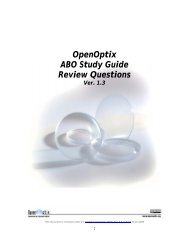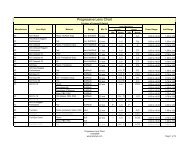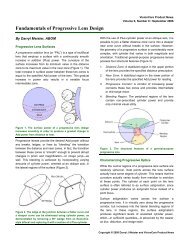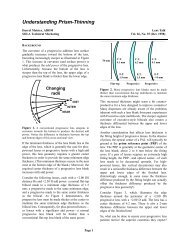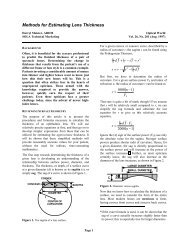OpenOptix ABO Study Guide - Laramy-K Optical
OpenOptix ABO Study Guide - Laramy-K Optical
OpenOptix ABO Study Guide - Laramy-K Optical
Create successful ePaper yourself
Turn your PDF publications into a flip-book with our unique Google optimized e-Paper software.
Cons<br />
Does not accept tint<br />
Not impact resistant<br />
Heavy<br />
CR-39<br />
Developed by PPG during WWII, CR-39, also known as plastic or hard resin, serves as a<br />
much lighter lens material (approximately 50% lighter) than glass. CR-39, however, is far<br />
less scratch resistant and often must be coated to improve its scratch resistant<br />
characteristics.<br />
Index: 1.498<br />
Pros<br />
Lighter than glass<br />
Readily tintable<br />
Less likely to fog<br />
Cons<br />
Susceptible to scratching (correctable by coating)<br />
Lower index of refraction makes it less suitable for higher powered prescriptions<br />
Polycarbonate<br />
While its optical characteristics are less than ideal, polycarbonate, the same material used<br />
for bullet-proof glass, is the most impact resistant of lens materials. Consequently,<br />
polycarbonate is the material of choice for safety and children’s eyewear. With an index<br />
of 1.59, polycarbonate also produces thinner, lighter lenses than glass or plastic. These<br />
factors along with polycarbonate’s inherent UV protection and pricing make it a popular<br />
material.<br />
Index: 1.59<br />
This document is licensed under the Creative Commons Attribution 3.0 License. 7/30/2009<br />
32



